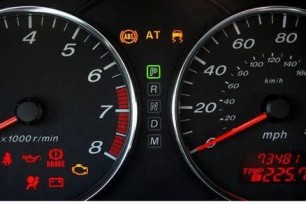Blog Details - Magma HDI

Five car dashboard warnings that you shouldn't neglect 14th December 2021
Your vehicle’s dashboard is usually something you don't give much attention to. That's because, unless something goes wrong, it often appears the same every time you drive. Cars have thousands of moving components comprising dozens of linked systems powered by cutting-edge technology and sensors. With that much computing power on board, if any error occurs, your car will undoubtedly alert you about them.
All the warning indicators in your car are explained in detail in your car's user manual, but reading through it may seem like a chore to many. However, the warning lights are there for a reason, and knowing what they represent can prove to be the difference between a good trip and a breakdown.
Here are five warnings that appear on all vehicle dashboards that you should never ignore.
1. Engine warning indicator:
This indicator means there might be a problem with your engine's primary systems. This problem might be as minor as a faulty sensor or a damaged spark plug or as severe as a damaged fuel pump. This indicator blinks for a few seconds when you start your vehicle. If the indicator remains on or blinks continuously, it indicates a serious problem.
2. Oil pressure indicator:
This indicator means that your engine's oil pressure is low. This might also mean that you're keeping low on engine oil. If this light comes on, turn off your ignition right away. Oil's shortage can cause irreversible engine damage. Check the oil level once you've parked safely on level ground. Fill it up if it's below the required mark. If the oil level is adequate, this might indicate a problem with the oil pump.
3. Brake warning indicator:
This indicator shows that you have left the handbrake on. Still, if it continues to flash even after you release the handbrake, it might indicate a problem associated with the braking system. See a mechanic right away.
4. Battery indicator:
It signifies that the alternator responsible for charging your car battery is malfunctioning and cannot provide an adequate charge. As the cells degrade with time, it might also be an issue with the battery. With the alternator and battery functioning poorly, you should minimize its load by turning off systems like AC and LEDs. Find a mechanic at the earliest because there may come a time when your vehicle won't start at all.
5. Engine temperature indicator:
The indicator typically signifies either your engine is overheating, or your coolant level is low and needs refilling. When this indicator flashes, it’s best that you immediately come to a halt and allow your engine to cool down. Check your coolant level and search for any leaks once the car engine has cooled. If the coolant level is correct, this indicator trigger might be a sign of a more severe issue, such as a damaged water pump.
An overheated engine can distort, causing parts to fail. Avoid driving further and tow your vehicle to the mechanic to avoid further damage to your car’s engine. Your car insurance features like roadside assistance will help you get complete service in case of any mishap in the middle of the road. You can enjoy the benefits of car insurance coverage without spending money from your side.
While these indicators signal that something needs attention, there is typically no reason to be alarmed. Most warning indicators will not leave you stuck, so you can generally safely drive yourself to a service station. Remember that these indicators change across automobile manufacturers and even within the same manufacturer's models. It is best to check with your mechanic if something worrisome flashes on your vehicle dashboard before it gets you in trouble.
Click HERE to know more about different car insurance plans suited for your car.
Disclaimer: The information provided above is for illustrative purposes only. To get more details, please refer to policy wordings and prospectus before purchasing a policy.

